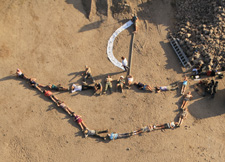post-Roman eras
Historical Outline
By the mid-third century C.E., the city of Dor had deteriorated to little more than a fishing village, and the tell appears to be abandoned at that point. This is by no means the end of the history of the place, though. From the fourth to the seventh century C.E. Dor was the center of a bishopric, and several bishops of Dor are mentioned in church records. The settlement appears to have migrated off the ancient tell to the area east of it, and was centered around the church complex, which served as a way-station for pilgrims on their way to the holy places. The church was excavated by J. Leibowitz in 1950 - 1952, and then again by C. Dauphin in 1979 - 1983 and by S. Gibson and Dauphin in 1994. The village of Tanturah, further south, was probably established after the abandonment of the church in the early Arab period.
 In the Middle Ages, a guard-tower or small fort
was established on the southwestern promontory of the tell, commanding the entrance
to the southern bay. A moat was constructed around it, to separate the cape
from the rest of the tell. Dor has been identified with the Crusader principality of
Merle, though some archaeological evidence indicates that the moat, at least, was dug
later (in the 13th century).
In the Middle Ages, a guard-tower or small fort
was established on the southwestern promontory of the tell, commanding the entrance
to the southern bay. A moat was constructed around it, to separate the cape
from the rest of the tell. Dor has been identified with the Crusader principality of
Merle, though some archaeological evidence indicates that the moat, at least, was dug
later (in the 13th century).
In 1799, when Napoleon Bonaparte laid siege to 'Acco, he used the anchorage at Dor as a supply depot and casualty-evacuation port. When the campaign failed, Dor was a base-station his retreat. Napoleon's hopes of meeting his Navy at Dor and evacuating by sea were dashed, and he dumped his heavy ordinance in the bay, so as to be able to use all the horses for carrying the wounded. Several artillery pieces, muskets, and ammunition were found in underwater surveys around Dor.
In 1891, baron Edmond de-Rothschild established a glass factory and a small Jewish settlement at Dor, north of the Arab village of Tanturah. The plan was to use the local sand for raw-material for making glass bottles for the winery at Zichron Ya'akov, as well as other glass objects. Meir Dizengoff (later to be the first mayor of Tel Aviv) was the plant manager. The venture failed, however, and the plant was closed in 1895. The historic building still stands, though, and houses the site-museum.
In one of the early actions of the 1948 war the village of Tanturah, which was part of an Arab enclave cutting the road from Tel Aviv to Haifa, was captured by the infant IDF in a night battle. Some of its original inhabitants still live in nearby Fureidis. In its place, two new settlements were established in the 1950's: Kibbutz Nahsholim, just southeast of the ancient tell and Moshav Dor, by the southernmost bay.
Documents from Kibutz Nahsholim archive
Document 1
Document 2
Document 3
